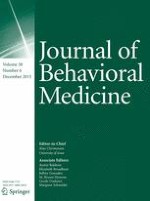11-07-2015
Impact of a brief intervention on self-regulation, self-efficacy and physical activity in older adults with type 2 diabetes
Gepubliceerd in: Journal of Behavioral Medicine | Uitgave 6/2015
Log in om toegang te krijgenAbstract
Despite evidence of the benefits of physical activity, most individuals with type 2 diabetes do not meet physical activity recommendations. The purpose of this study was to test the efficacy of a brief intervention targeting self-efficacy and self-regulation to increase physical activity in older adults with type 2 diabetes. Older adults (Mage = 61.8 ± 6.4) with type 2 diabetes or metabolic syndrome were randomized into a titrated physical activity intervention (n = 58) or an online health education course (n = 58). The intervention included walking exercise and theory-based group workshops. Self-efficacy, self-regulation and physical activity were assessed at baseline, post-intervention, and a follow-up. Results indicated a group by time effect for self-regulation [F(2,88) = 14.021, p < .001, η
2 = .24] and self-efficacy [F(12,77) = 2.322, p < .05, η
2 = .266] with increases in the intervention group. The intervention resulted in short-term increases in physical activity (d = .76, p < .01), which were partially maintained at the 6-month follow-up (d = .35, p < .01). The intervention increased short-term physical activity but was not successful at maintaining increases in physical activity. Similar intervention effects were observed in self-efficacy and self-regulation. Future research warrants adjusting intervention strategies to increase long-term change.
